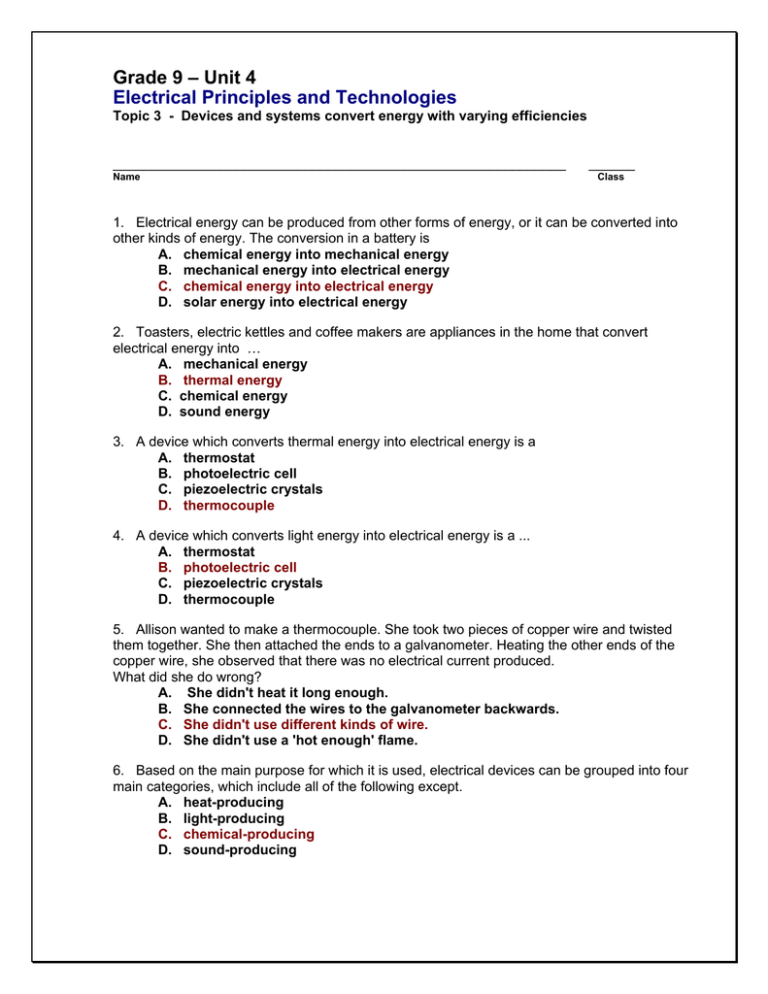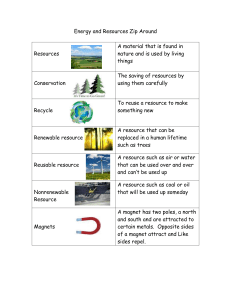Grade9 - Unit4 Electrical Principles and Technologies
advertisement

Grade 9 – Unit 4 Electrical Principles and Technologies Topic 3 - Devices and systems convert energy with varying efficiencies ___________________________________________________________ Name ______ Class 1. Electrical energy can be produced from other forms of energy, or it can be converted into other kinds of energy. The conversion in a battery is A. chemical energy into mechanical energy B. mechanical energy into electrical energy C. chemical energy into electrical energy D. solar energy into electrical energy 2. Toasters, electric kettles and coffee makers are appliances in the home that convert electrical energy into … A. mechanical energy B. thermal energy C. chemical energy D. sound energy 3. A device which converts thermal energy into electrical energy is a A. thermostat B. photoelectric cell C. piezoelectric crystals D. thermocouple 4. A device which converts light energy into electrical energy is a ... A. thermostat B. photoelectric cell C. piezoelectric crystals D. thermocouple 5. Allison wanted to make a thermocouple. She took two pieces of copper wire and twisted them together. She then attached the ends to a galvanometer. Heating the other ends of the copper wire, she observed that there was no electrical current produced. What did she do wrong? A. She didn't heat it long enough. B. She connected the wires to the galvanometer backwards. C. She didn't use different kinds of wire. D. She didn't use a 'hot enough' flame. 6. Based on the main purpose for which it is used, electrical devices can be grouped into four main categories, which include all of the following except. A. heat-producing B. light-producing C. chemical-producing D. sound-producing 7. Drills, saws, vacuums, fans and food processors are all examples (applications) of this type of energy conversion … A. electrical energy to mechanical energy B. mechanical energy to thermal energy C. electrical energy to chemical energy D. mechanical energy to sound energy 8. Your house electricity enters through an electric meter. It records your usage of electricity, which is then recorded by a meter person, who reads the dials on the face of the electric meter. Your electricity usage is recorded in these units. A. volts B. watts C. amperes D. kilowatts 9. When electrical energy passes over a compass, this happens to the compass needle. It A. spins B. is deflected C. rotates clockwise D. rotates counterclockwise 10. These reverse the direction of flow in the electromagnetic coil of a motor... A. power source and armature B. armature and bushes C. commutator and brushes D. commutator and armature 11. Mr. Jones was trying to make an electromagnetic coil to demonstrate the power it has. His coil worked, but not very well. The most likely reason was because the A. coil was made of copper wire B. battery was brand new C. metal core was too thin D. battery was dead Identify the Electricity RULE not being observed in each of the next three scenarios 12. "The problem with this computer game", said Matt, "is that the power bar keeps popping its circuit. I think that I need a better power bar, so I can play my game without interruption." A. Don't use electricity near water B. Improper or unsafe equipment C. Keep a safe distance high voltage D. Don't use more electricity than recommended 13. While sitting at his desk, Albert was playing with the electric cord to the stereo. The little bits of plastic he was able to rub off exposed the copper wire, giving him a shock. A. Don't use electricity near water B. Improper or unsafe equipment C. Keep a safe distance high voltage D. Don't use more electricity than recommended 14. Mr. Jones was cutting his lawn with his new electric lawn mower. He even continued, when it started to rain, because this model was able to pick up wet clippings with ease A. Don't use electricity near water B. Improper or unsafe equipment C. Keep a safe distance high voltage D. Don't use more electricity than recommended 15. It is necessary for Urban power companies to reduce voltage to communities. They are able to do this with a step-down transformer. This type of transformer reduces voltage because... A. the primary coil is larger than the secondary coil B. the secondary coil is larger than the primary coil C. it is coiled in reverse directions D. it is coiled with more wires 16. The primary difference between direct and alternating current is that direct current . A. flows in only one direction B. flows back and forth 10 times per second C. flows back and forth 30 times per second D. flows back and forth 60 times per second 17. Michael Faraday’s discovery of electromagnetic induction in 1831, led to this ... A. transformer B. generator C. battery D. split ring comutator 18. A kitchen clock is usually left on all day. It has a power rating of 4 watts. With the cost of electricity, in Alberta, $0.11 per kilowatt hour, what is the cost of operating the clock for one year? A. $ 385.44 B. $ 38.54 C. $ 3.85 D. $ 0.39 19. A ghetto blaster has a power rating of 28 watts. If it was on each day (all day) during an average month (30 days) and the cost of electricity, in Alberta, is $0.11 per kilowatt hour. What is the cost of operating the ghetto blaster for one month? A. $ 221.78 B. $ 22.18 C. $ 2.22 D. $ 2217.60 20. The efficiency of a device is the ratio of the useful energy that comes out of a device to the total energy that goes in. A light bulb gives off 5J of useful light energy for every 100J of electrical energy used to make it work. What is the efficiency of the light bulb? A. 105 % B. 95 % C. 20 % D. 5 %

